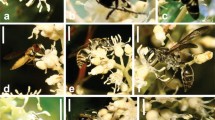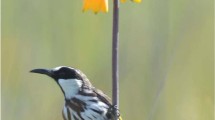Abstract
Nectar standing crops in flowers within an individual plant are often highly variable. This variability may be a by-product of the foraging activity of insect pollinators. Alternatively, plants may be selected to produce highly variable rewards to reduce consecutive visitation by risk-averse pollinators, thus diminishing within-plant pollen transfer. This study evaluated the roles of pollinator control vs. plant control over nectar variability in the bee-pollinated shrub Rosmarinus officinalis L. (Lamiaceae). We sampled nectar production, standing crop and pollinator visits in three shrubs of one population over 17 days during one blooming season. Nectar production rates were highly variable (CV = 1.48), and increased after rainy days. Nectar standing crops were even more variable (CV = 2.16), decreased with increasing temperatures, and increased with time since the last rain. Pollinator visit rates decreased with variability in nectar standing crops, increased with flower number per shrub, and were unaffected by variability in nectar production rates. Repeated sampling of marked flowers revealed no correlation between their nectar standing crops and production rates. These findings support the role of reward variance in reducing pollinator visits, but suggest that plants are not in complete control of this variability. Rather, plant-generated variability can be modified by intensive foraging activity of pollinators. Such pollinator control over nectar variability is likely to reduce the selective advantage of plant-generated reward variation.



Similar content being viewed by others
Explore related subjects
Discover the latest articles and news from researchers in related subjects, suggested using machine learning.References
Barrett SCH (2003) Mating strategies in flowering plants: the outcrossing–selfing paradigm and beyond. Philos Trans R Soc Lond B 358:991–1004
Biernaskie JM, Cartar RV, Hurly TA (2002) Risk-averse inflorescence departure in hummingbirds and bumble bees: could plants benefit from variable nectar volumes? Oikos 98:98–104
Boose DL (1997) Sources of variation in floral nectar production rate in Epilobium canum (Onagraceae): implications for natural selection. Oecologia 110:493–500
Brody AK, Mitchell RJ (1997) Effects of experimental manipulation of inflorescence size on pollination and pre-dispersal seed predation in the hummingbird-pollinated plant Ipomopsis aggregata. Oecologia 110:86–93
Burns JG, Thomson JD (2006) A test of spatial memory and movement patterns of bumblebees at multiple spatial and temporal scales. Behav Ecol 17:48–55
Carlson JE, Harms KE (2006) The evolution of gender-biased nectar production in hermaphroditic plants. Bot Rev 72:179–205
Carroll AB, Pallardy SG, Galen C (2001) Drought stress, plant water status, and floral trait expression in fireweed, Epilobium angustifolium (Onagraceae). Am J Bot 88:438–446
Castellanos MC, Wilson P, Thomson JD (2002) Dynamic nectar replenishment in flowers of Penstemon (Scrophulariaceae). Am J Bot 89:111–118
Galetto L, Bernardello M, Juliani HR (1994) Characteristics of secretion of nectar in Pyrostegia venusta (Ker-Gawl.) Miers (Bignoniaceae). New Phytol 127:465–471
de Jong TJ, Klinkhamer PGL (2005) Evolutionary ecology of plant reproductive strategies. Cambridge University Press, Cambridge, New York
de Jong TJ, Waser NM, Klinkhamer PGL (1993) Geitonogamy: the neglected side of selfing. Trends Ecol Evol 8:321–325
Feinsinger P (1983) Variable nectar secretion in a Heliconia species pollinated by hermit hummingbirds. Biotropica 15:48–52
Goulson D, Stout JC, Hawson SA, Allen JA (1998) Floral display size in comfey, Symphytum officinale L (Boraginaceae): relationships with visitation by three bumblebee species and subsequent seed set. Oecologia 113:502–508
Herrera CM, Soriguer RC (1983) Intra- and inter-floral heterogeneity of nectar production in Helleborus foetidus L. (Ranunculaceae). Bot J Linn Soc 86:253–260
Hidalgo PJ, Ubera JL (2001) Inbreeding depression in Rosmarinus officinalis L. Int J Dev Biol 45(S1):S43–S44
Kacelnik A, Bateson M (1996) Risky theories—the effects of variance on foraging decisions. Am Zool 36:402–434
Kadmon R, Shmida A (1992) Departure rules used by bees foraging for nectar: a field test. Evol Ecol 6:142–151
Keasar T, Shmida A, Motro U (1996) Innate movement rules in foraging bees: flight distances are affected by recent rewards and are correlated with choice of flower type. Behav Ecol Sociobiol 39:381–388
Keasar T, Rashkovich E, Cohen D, Shmida A (2002) Bees in two-armed bandit situations: foraging choices and possible decision mechanisms. Behav Ecol 13:757–765
Klinkhamer PGL, de Jong TJ (1990) Effects of plant size, plant density and sex differential nectar reward on pollinator visitation in the protandrous Echium vulgare (Boraginaceae). Oikos 57:399–405
Klinkhamer PGL, de Jong TJ, Metz JAJ (1994) Why plants can be too attractive—a discussion of measures to estimate male fitness. J Ecol 82:191–194
Leiss KA, Klinkhamer PGL (2005) Genotype by environment interactions in the nectar production of Echium vulgare. Funct Ecol 19:454–459
Lewontin RC (1966) On the measurement of relative variability. Syst Zool 15:141–142
Marden JH (1984) Intrapopulation variation in nectar secretion in Impatiens capensis. Oecologia 63:418–422
Motro U, Shmida A (1995) Near-Far search: an evolutionarily stable foraging strategy. J Theor Biol 173:15–22
Ohashi K, Yahara T (2001) Behavioural responses of pollinators to variation in floral display size and their influences on the evolution of floral traits. In: Chittka L, Thomson JD (eds) Cognitive ecology of pollination. Cambridge University Press, Cambridge, New York, pp 274–296
Pappers SM, de Jong TJ, Klinkhamer PGL, Meelis E (1999) Effects of nectar content on the number of bumblebee approaches and the length of visitation sequences in Echium vulgare (Boraginaceae). Oikos 87:580–586
Pleasants JM (1983) Nectar production patterns in Ipomopsis aggregata (Polemoniaceae). Am J Bot 70:1468–1475
Pleasants JM, Chaplin SJ (1983) Nectar production rates of Ascelapias quadrifolia: causes and consequences of individual variation. Oecologia 59:232–238
Rathcke BJ (1992) Nectar distributions, pollinator behavior, and plant reproductive success. In: Hunter MD, Ogushi T, Price PW (eds) Effects of resource distribution on animal–plant interactions. Academic Press, NY, pp 113–138
Reusch TBH (2001) Fitness-consequences of geitonogamous selfing in a clonal marine angiosperm (Zostera marina). J Evol Biol 14:129–138
Robertson AW, MacNair MR (1995) The effects of floral display size on pollinator service to individuals flowers of Myosotis and Mimulus. Oikos 72:106–114
Shafir S (2000) Risk-sensitive foraging: the effect of relative variability. Oikos 89:663–669
Shmida A, Kadmon R (1991) Within-plant patchiness in nectar standing crop in Anchusa strigosa. Plant Ecol 94:95–99
Southwick AK, Southwick EE (1983) Aging effect on nectar production in two clones of Asclepias syriaca. Oecologia 56:121–125
Wyatt R, Broyles SB, Derda GS (1992) Environmental influences on nectar production in milkweeds (Ascelapias syriaca and A. exaltata). Am J Bot 79:636–642
Zimmerman M, Pyke GH (1986) Reproduction in Polemonium: patterns and implications of floral nectar production and standing crops. Am J Bot 73:1405–1415
Acknowledgements
The field work was supported by the Jewish National Fund. Data analysis and writing were supported by the research group on Evolution and Game Theory at the Institute of Advanced Studies, The Hebrew University. Tom de Jong commented on the manuscript. The experiments comply with the current laws of the State of Israel.
Author information
Authors and Affiliations
Corresponding author
Additional information
Handling Editor: Neal Williams.
Rights and permissions
About this article
Cite this article
Keasar, T., Sadeh, A. & Shmida, A. Variability in nectar production and standing crop, and their relation to pollinator visits in a Mediterranean shrub. Arthropod-Plant Interactions 2, 117–123 (2008). https://doi.org/10.1007/s11829-008-9040-9
Received:
Accepted:
Published:
Issue Date:
DOI: https://doi.org/10.1007/s11829-008-9040-9




